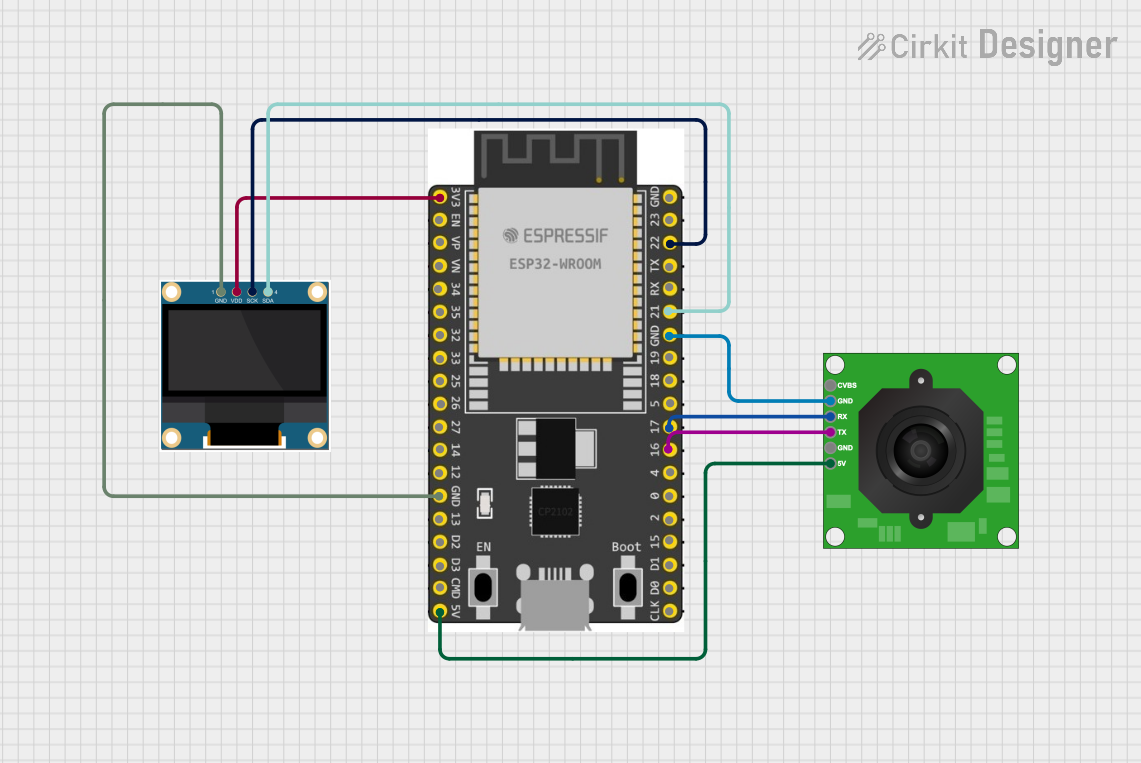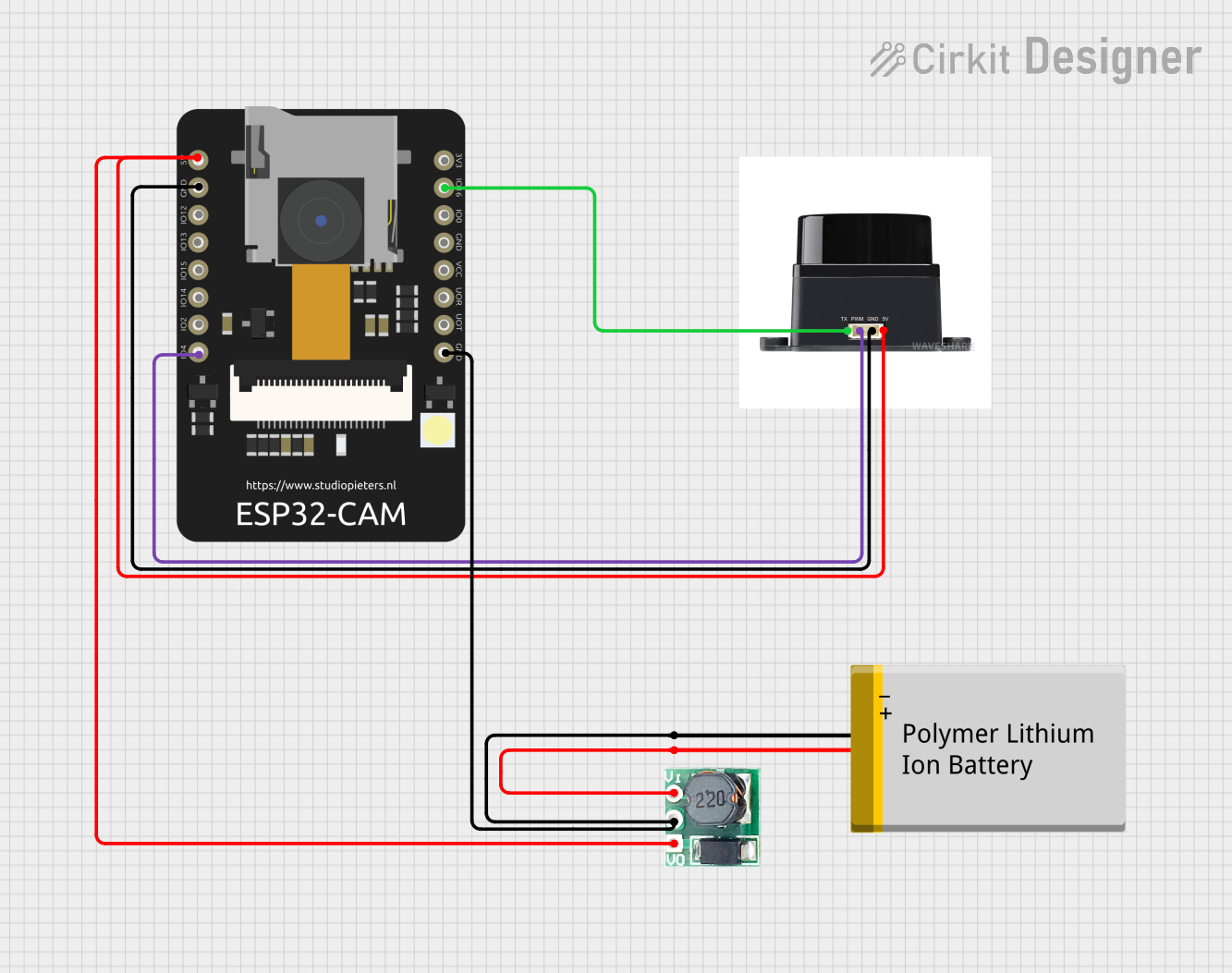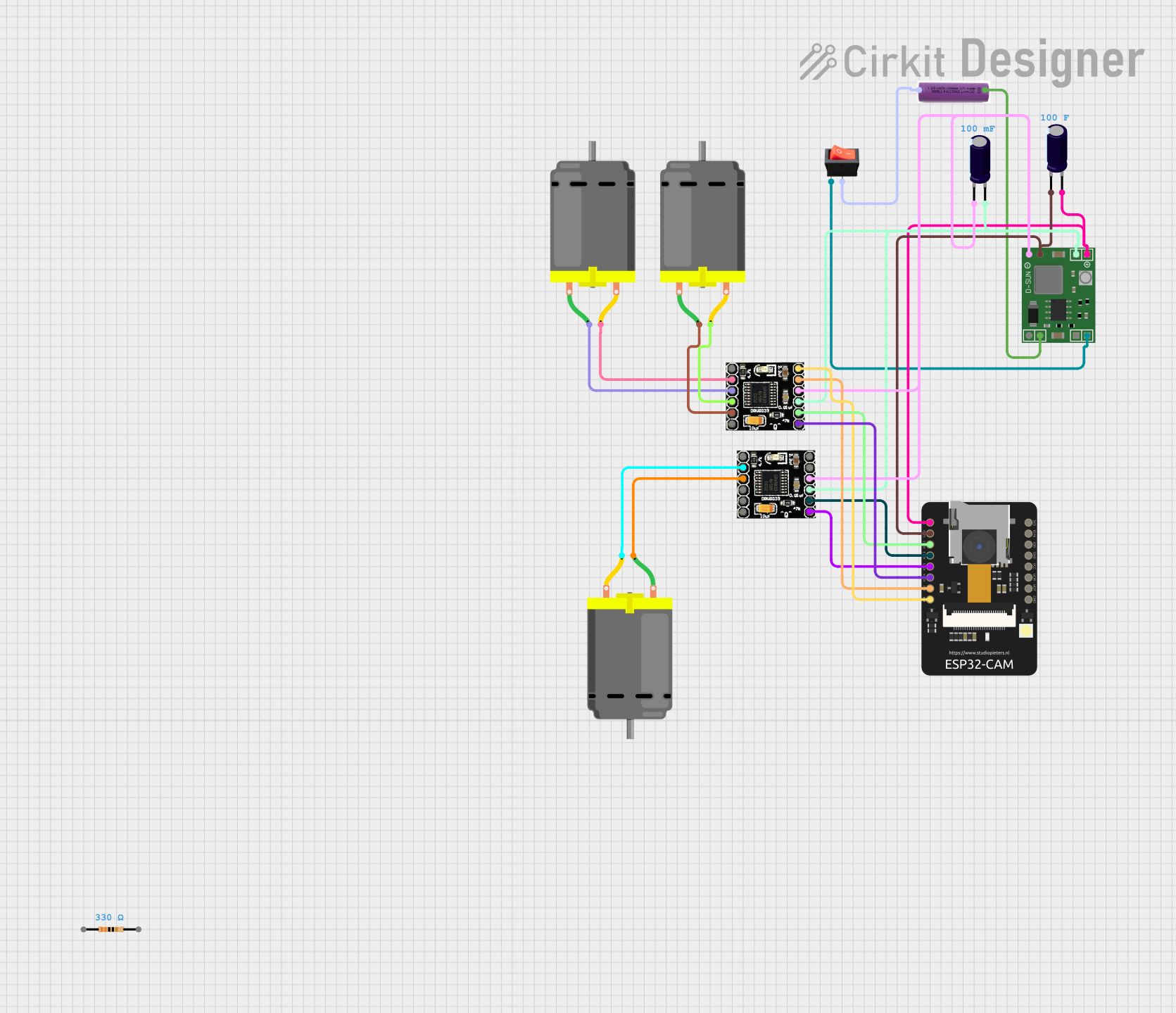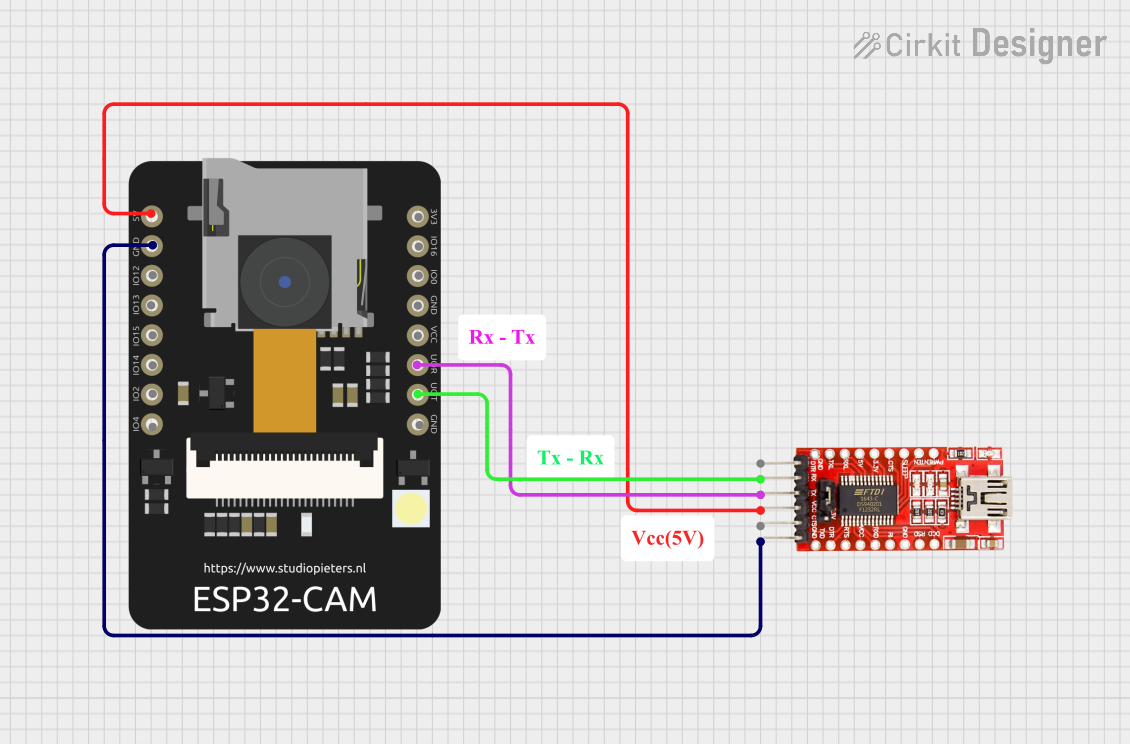
How to Use ESP32-S3-Camera: Examples, Pinouts, and Specs

 Design with ESP32-S3-Camera in Cirkit Designer
Design with ESP32-S3-Camera in Cirkit DesignerIntroduction
The ESP32-S3-Camera (manufacturer part ID: S3-CAM) is a powerful microcontroller developed by ESP. It features integrated Wi-Fi and Bluetooth capabilities, along with a dedicated camera interface for image capture and processing. This component is designed for IoT applications, smart devices, and projects requiring advanced image processing and wireless communication.
The ESP32-S3-Camera is ideal for applications such as:
- Smart home devices (e.g., security cameras, video doorbells)
- IoT-enabled surveillance systems
- AI-powered image recognition and processing
- Remote monitoring and control systems
- Educational and prototyping projects
Explore Projects Built with ESP32-S3-Camera

 Open Project in Cirkit Designer
Open Project in Cirkit Designer
 Open Project in Cirkit Designer
Open Project in Cirkit Designer
 Open Project in Cirkit Designer
Open Project in Cirkit Designer
 Open Project in Cirkit Designer
Open Project in Cirkit DesignerExplore Projects Built with ESP32-S3-Camera

 Open Project in Cirkit Designer
Open Project in Cirkit Designer
 Open Project in Cirkit Designer
Open Project in Cirkit Designer
 Open Project in Cirkit Designer
Open Project in Cirkit Designer
 Open Project in Cirkit Designer
Open Project in Cirkit DesignerTechnical Specifications
The ESP32-S3-Camera is built on the ESP32-S3 microcontroller platform, offering high performance and flexibility. Below are the key technical specifications:
General Specifications
| Parameter | Value |
|---|---|
| Microcontroller | ESP32-S3 |
| Wireless Connectivity | Wi-Fi 802.11 b/g/n, Bluetooth 5.0 |
| Camera Interface | 8-bit DVP (Digital Video Port) |
| Flash Memory | Up to 16 MB (external SPI flash) |
| PSRAM | Up to 8 MB (external) |
| Operating Voltage | 3.3V |
| GPIO Pins | 45 (configurable for various peripherals) |
| CPU | Dual-core Xtensa LX7, up to 240 MHz |
| AI Acceleration | Vector instructions for AI/ML workloads |
| Operating Temperature | -40°C to 85°C |
Pin Configuration
The ESP32-S3-Camera module includes a variety of pins for power, communication, and camera interfacing. Below is a summary of the key pin configurations:
Power and Ground Pins
| Pin Name | Description |
|---|---|
| 3V3 | 3.3V power input |
| GND | Ground |
Camera Interface Pins
| Pin Name | Description |
|---|---|
| D0-D7 | Camera data pins (8-bit) |
| VSYNC | Vertical sync signal |
| HREF | Horizontal reference signal |
| PCLK | Pixel clock |
| XCLK | External clock input |
| RESET | Camera reset signal |
Communication Pins
| Pin Name | Description |
|---|---|
| TXD0 | UART0 transmit |
| RXD0 | UART0 receive |
| SCL | I2C clock |
| SDA | I2C data |
| MOSI | SPI master-out, slave-in |
| MISO | SPI master-in, slave-out |
| SCK | SPI clock |
| CS | SPI chip select |
Usage Instructions
The ESP32-S3-Camera can be used in a variety of projects, from simple image capture to advanced AI-based image recognition. Below are the steps to get started:
Connecting the ESP32-S3-Camera
- Power the Module: Connect the 3V3 pin to a 3.3V power source and GND to ground.
- Connect the Camera: Attach a compatible camera module (e.g., OV2640) to the camera interface pins (D0-D7, VSYNC, HREF, PCLK, XCLK, RESET).
- Set Up Communication: Use UART, I2C, or SPI for communication with other devices or microcontrollers.
- Program the Module: Use the Arduino IDE or ESP-IDF (Espressif IoT Development Framework) to upload your code.
Example Code for Arduino IDE
Below is an example of how to capture an image using the ESP32-S3-Camera and save it to an SD card:
#include "esp_camera.h"
#include "SD_MMC.h"
// Configure the camera pins
#define PWDN_GPIO_NUM -1 // Power down pin not used
#define RESET_GPIO_NUM -1 // Reset pin not used
#define XCLK_GPIO_NUM 0 // External clock pin
#define SIOD_GPIO_NUM 26 // I2C data pin
#define SIOC_GPIO_NUM 27 // I2C clock pin
#define Y9_GPIO_NUM 35 // Camera data pins
#define Y8_GPIO_NUM 34
#define Y7_GPIO_NUM 39
#define Y6_GPIO_NUM 36
#define Y5_GPIO_NUM 21
#define Y4_GPIO_NUM 19
#define Y3_GPIO_NUM 18
#define Y2_GPIO_NUM 5
#define VSYNC_GPIO_NUM 25 // Vertical sync pin
#define HREF_GPIO_NUM 23 // Horizontal reference pin
#define PCLK_GPIO_NUM 22 // Pixel clock pin
void setup() {
Serial.begin(115200);
// Initialize the camera
camera_config_t config;
config.ledc_channel = LEDC_CHANNEL_0;
config.ledc_timer = LEDC_TIMER_0;
config.pin_d0 = Y2_GPIO_NUM;
config.pin_d1 = Y3_GPIO_NUM;
config.pin_d2 = Y4_GPIO_NUM;
config.pin_d3 = Y5_GPIO_NUM;
config.pin_d4 = Y6_GPIO_NUM;
config.pin_d5 = Y7_GPIO_NUM;
config.pin_d6 = Y8_GPIO_NUM;
config.pin_d7 = Y9_GPIO_NUM;
config.pin_xclk = XCLK_GPIO_NUM;
config.pin_pclk = PCLK_GPIO_NUM;
config.pin_vsync = VSYNC_GPIO_NUM;
config.pin_href = HREF_GPIO_NUM;
config.pin_sscb_sda = SIOD_GPIO_NUM;
config.pin_sscb_scl = SIOC_GPIO_NUM;
config.pin_pwdn = PWDN_GPIO_NUM;
config.pin_reset = RESET_GPIO_NUM;
config.xclk_freq_hz = 20000000;
config.pixel_format = PIXFORMAT_JPEG;
if (esp_camera_init(&config) != ESP_OK) {
Serial.println("Camera init failed");
return;
}
// Initialize SD card
if (!SD_MMC.begin()) {
Serial.println("SD Card Mount Failed");
return;
}
// Capture an image
camera_fb_t *fb = esp_camera_fb_get();
if (!fb) {
Serial.println("Camera capture failed");
return;
}
// Save the image to the SD card
File file = SD_MMC.open("/image.jpg", FILE_WRITE);
if (!file) {
Serial.println("Failed to open file for writing");
return;
}
file.write(fb->buf, fb->len);
file.close();
esp_camera_fb_return(fb);
Serial.println("Image saved to SD card");
}
void loop() {
// Nothing to do here
}
Best Practices
- Use a stable 3.3V power supply to avoid damage to the module.
- Ensure proper grounding to prevent noise in the camera signals.
- Use heat sinks or cooling if the module operates in high-temperature environments.
- When using Wi-Fi, ensure the antenna is not obstructed for optimal signal strength.
Troubleshooting and FAQs
Common Issues
Camera Initialization Fails
- Ensure the camera is properly connected to the interface pins.
- Verify the camera module is compatible with the ESP32-S3-Camera.
Image Capture Fails
- Check the power supply voltage (must be 3.3V).
- Ensure the SD card is properly formatted and inserted.
Wi-Fi or Bluetooth Connectivity Issues
- Verify the antenna is connected and unobstructed.
- Check the Wi-Fi credentials in your code.
FAQs
Q: Can I use a different camera module?
A: Yes, as long as the camera module supports an 8-bit DVP interface and is compatible with the ESP32-S3.
Q: What is the maximum resolution supported?
A: The maximum resolution depends on the camera module used. For example, the OV2640 supports up to 1600x1200 (UXGA).
Q: Can I use this module with an Arduino UNO?
A: No, the ESP32-S3-Camera is a standalone microcontroller and does not require an Arduino UNO. However, it can communicate with other microcontrollers via UART, I2C, or SPI.
Q: How do I update the firmware?
A: Use the ESP-IDF or Arduino IDE to upload new firmware via the USB interface or OTA (Over-the-Air) updates.